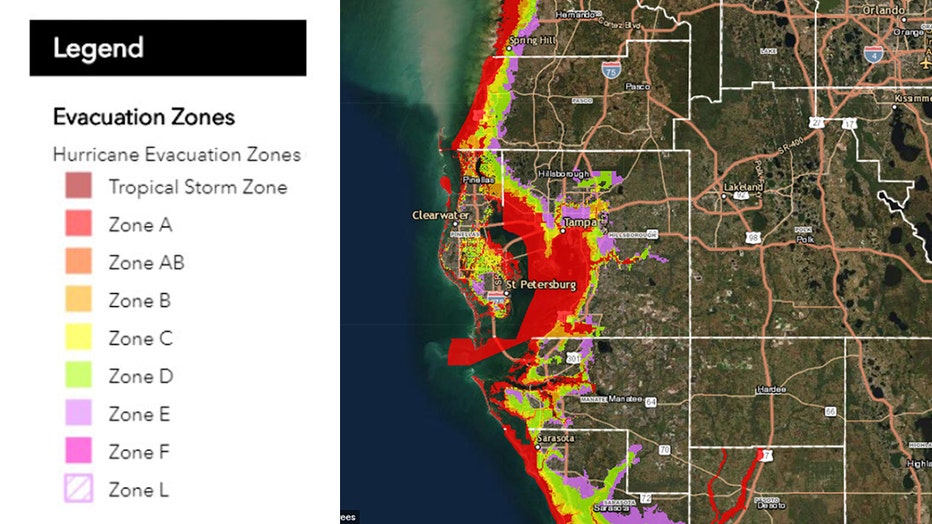Know your zone: Florida evacuation zones, what they mean, and when to leave
TAMPA, Fla. - The main way people die when a hurricane hits Florida is storm surge, according to the state's Know Your Zone website.
Storm surge is a dome of water pushed onto land by powerful hurricane winds. The force of the water can move buildings and cause more damage than hurricane winds, on their own.
SEARCH BY ADDRESS FOR STORM SURGE EVACUATION ZONES
As evacuations are ordered ahead of Hurricane Ian, it's important for residents across Florida to know if they are in a storm surge evacuation zone, so they can be prepared to leave when officials give the orders.
Meteorologist say "run from water, hide from wind." Storm surge is the reason for this saying.
County by county: Hurricane Ian emergency information
Low-lying areas vs storm surge
Storm surge evacuation zones are different from low-lying areas. Those are areas prone to flooding due to rainfall and saturated grounds. Evacuation information for low-lying areas is typically given as a recommendation.
Flood zones are similarly named to storm surge evacuation zones. Don't confuse "Flood Zone A" with "Evacuation Zone A."
See if your home is in a so-called low-lying area flood zone on the FEMA website: https://www.fema.gov/glossary/flood-zones.
Storm surge evacuation zones
Evacuation zones are titled:
- Tropical Storm Zone (Only used in Hendry County)
- A
- AB (Only used in Monroe County)
- B
- C
- D
- E
- F (Only used in Collier, Duval, Flagler, Nassau, St. Johns counties)
- L (Only used in Palm Beach County)
Storm surge zones are based on the likelihood an area will flood with the projected rise in sea level due to a hurricane.
Evacuations will be issued for Zone A when storm surge is predicted up to 11 feet.
Evacuations will be issued for zone A-B when storm surge is predicted up to 15 feet.
Evacuations will be issued for zone A-C when storm surge is predicted up to 20 feet.
Evacuations will be issued for zone A-D when storm surge is predicted up to 28 feet.
Evacuations will be issued for Zone A-E when storm surge is predicted up to 35 feet.
2022: Pinellas County updates evacuation zones for nearly 48,000 households ahead of hurricane season
For more information about how storm surge is measured and monitored, visit the National Hurricane Center's storm surge FAQ page: https://www.nhc.noaa.gov/surge/faq.php#2
How to decide when to leave

If you live in a zone that has been ordered to evacuate, get out. However, that doesn't mean you have to leave the state, or even the county where you live.
2022: Hillsborough County releases new evacuation zones for residents
Evacuation orders are given for storm surge zones in order to keep residents safe from the risk of storm surge flooding. The flooding typically subsides after the storm passes and residents will be allowed to return to their homes.
Officials say, if you're given orders to evacuate your home, look for higher ground nearby, if possible.
Florida's highways and interstates tend to become congested as many people try to flee the state ahead of a storm. This puts drivers at risk of becoming stranded or being involved in accidents.
Additionally, officials monitor evacuation zones to prevent looting or other illegal activity, but when evacuation orders are lifted, it's best to return home and secure property and belongings.

